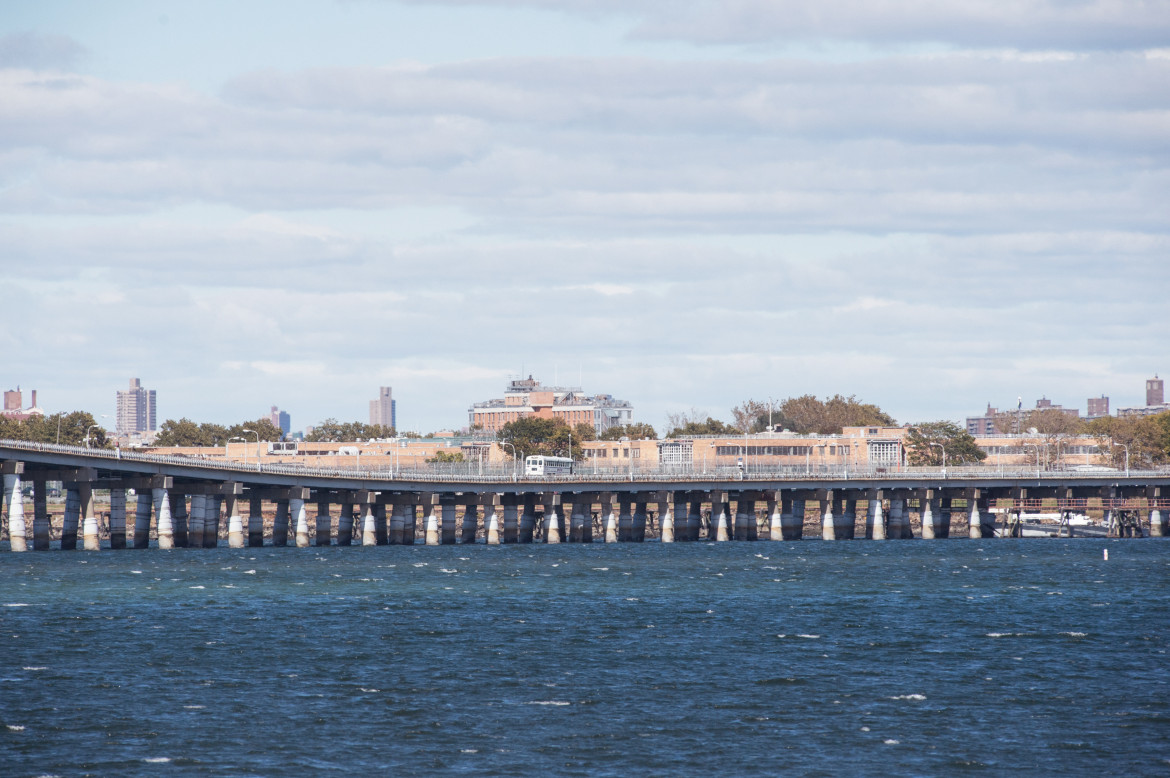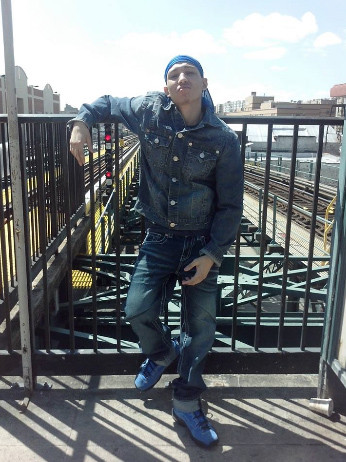
Robert Stolarik / JJIE
A view of Rikers Island from LaGuardia Airport Marine Terminal.
NEW YORK — Ruben Rodriguez walked into the Robert N. Daveron Complex (RNDC), the main adolescent house on Rikers Island, in a faded stone-colored jumpsuit on April 25. A number of inmates whom he recognized from his previous sentence, bristled with fear, but also showed respect and pity when Ruben said he was back on murder charges.
Ruben was one of two teenagers accused of fatally assaulting 28-year-old Luis Melendez with wooden poles, leaving him bleeding with injuries to his head, face and torso. The Bronx district attorney charged Ruben with murder in the second degree plus two lesser charges. Ruben was held without bail, which is standard for homicide cases in the Bronx, said Ruben’s defense attorney Arlen Yalkut.
Ruben was used to seeing people he knew wherever he was locked up — a shifting group of teen boys who primarily came from the south Bronx and the eastern fringes of Brooklyn. They aged together, in a way, like kids who overlapped sessions at a bloodthirsty summer camp, where homemade blades always came out during color wars.

Photo of Ruben Rodriguez taken in April, from Ruben's Facebook page.
Ruben wasn’t friends with everyone he recognized. In fact, many were Bloods — technically his rivals. But they moved in the same circles. One-on-one, Ruben discovered that even some Bloods were all right.
A mental health professional did a short intake evaluation on Ruben after his cell assignment. Ruben came away with a daily dose of anti-anxiety medication that he soon stopped taking.
“When they heard I was here for something as serious as murder — well, allegedly — they figured I’d go crazy,” Ruben surmised of his medical assessment.
The follow-up mental health evaluations were quick. Every six weeks or so, someone spent about five minutes asking Ruben if he felt suicidal or had any hallucinations. When he said no, the person moved on. The Department of Correction refused to comment for this story.
Ruben's story is an illustration of the need for a more rehabilitative approach on Rikers Island, but also underlies the reality that at least some young people at times show little interest in rehabilitation.
Back in the Box
After a month in RNDC, Ruben swapped his gray jumpsuit for orange and headed to the Box. His path to solitary had started about two weeks earlier, when he received an unsolicited gift — a package of ramen noodles from the commissary — from another inmate. The gesture roused Ruben’s suspicions, but he accepted it anyway.
The following week, the other inmate asked Ruben to sacrifice a phone call to contact someone on the inmate’s behalf. When Ruben refused, they argued. The two 17-year-olds moved into the bathroom, where there aren’t security cameras, and the other inmate cut Ruben’s left bicep with a small, concealed blade. Within a few minutes, correction officers (COs) stormed the bathroom and pepper sprayed Ruben’s eyes. Blinded, he collapsed and crawled around the floor, searching for a cool spot to rest his head.
 The fight landed Ruben in a higher-security unit filled with Bloods. As a Crip, Ruben felt like prey there. He and the handful of other Crips joined forces with a few Trinitarios, a New York-based Hispanic gang. The conglomerate forces still didn’t match up against the Bloods. As tensions grew, the two groups prepared to fight.
The fight landed Ruben in a higher-security unit filled with Bloods. As a Crip, Ruben felt like prey there. He and the handful of other Crips joined forces with a few Trinitarios, a New York-based Hispanic gang. The conglomerate forces still didn’t match up against the Bloods. As tensions grew, the two groups prepared to fight.
Once the common room was empty, they locked the doors and began. Everyone pulled out makeshift weapons. In the absence of “real” weapons, anything worked — a rigged utensil, a jagged sliver of glass, soap in a sock, scalding water from a hot plate.
About 10 minutes later, the Turtles — a team of helmeted emergency response officers — broke into the common room. Most of the inmates fled, but the Turtles caught Ruben and a handful of his allies.
COs don’t break up every fight, Ruben says. Rikers has cut staff by 20 percent in the last decade. Stretched thin, officers often supervise more inmates and jail space than they can physically see.
After a week in a transitional unit without showering, Ruben was sent to the juvenile Box in the third week of May. Inmates in solitary may make only one six-minute phone call a day and may buy only necessities from the commissary. That means no snacks. They get one hour of recreation, which means an hour locked in a single-occupancy outdoor cage.
Ruben had spent more than enough time in the Box — 90 days during one of the coldest New York winters on record — to stick it out. While settling into his cot on his first night, however, he experienced a novel feeling: regret. He wanted to leave Rikers, but for the first time he didn’t miss the streets. He missed home, and had no idea when he’d be there again.
An Endless Summer ...
Ruben grew antsy as June became July, and July became August. His parents visited separately almost every week, but he wasn’t notified until they registered inside Rikers Island. Then they had to get through an unpredictable security wait before a CO fetched him.
The girl who told Ruben she was getting an abortion did not follow up to confirm she had the procedure. Another girl, whom he called his “earth angel,” wasn’t allowed by her mother to come see him. Ruben wished Rikers allowed conjugal visits. Even if his girlfriends from home couldn’t visit, he said he’d met another girl or two over the phone.
Ruben said he stopped taking his optional hour of fresh air most days. That’s the norm, according to the New York City Board of Correction, which reported that fewer than 10 percent of inmates in the Central Punitive Segregation Unit (CPSU) went to their outdoor cages on any given day.
Not going crazy, Ruben felt, was evidence of his transition into manhood.
NOTE TO READERS: All interviews with Ruben were conducted on Rikers Island, where security rules prohibited taking notes of any kind.